Report on Tesco's Global Strategic Management and Analysis
VerifiedAdded on 2023/06/15
|12
|4131
|322
Report
AI Summary
This report provides a comprehensive analysis of Tesco's global strategic management, examining its business and corporate strategies, internal and external environments, strategic tools, and planning processes. It delves into how Tesco utilizes resource allocation, differentiation, cost leadership, and focus strategies to maintain a competitive edge. The report includes SWOT and PESTEL analyses to assess Tesco's strengths, weaknesses, opportunities, and threats, as well as the impact of political, economic, social, technological, environmental, and legal factors. Furthermore, it discusses strategic tools like Porter's Five Forces to evaluate industry competition and profitability. The report also outlines Tesco's mission, vision, and goals within its strategic planning framework, addressing contemporary strategic issues and different levels of strategy. It concludes with recommendations for Tesco to sustain its market position, emphasizing the importance of adapting to changing consumer behaviors and leveraging technological advancements. Desklib offers this and many more solved assignments for students.
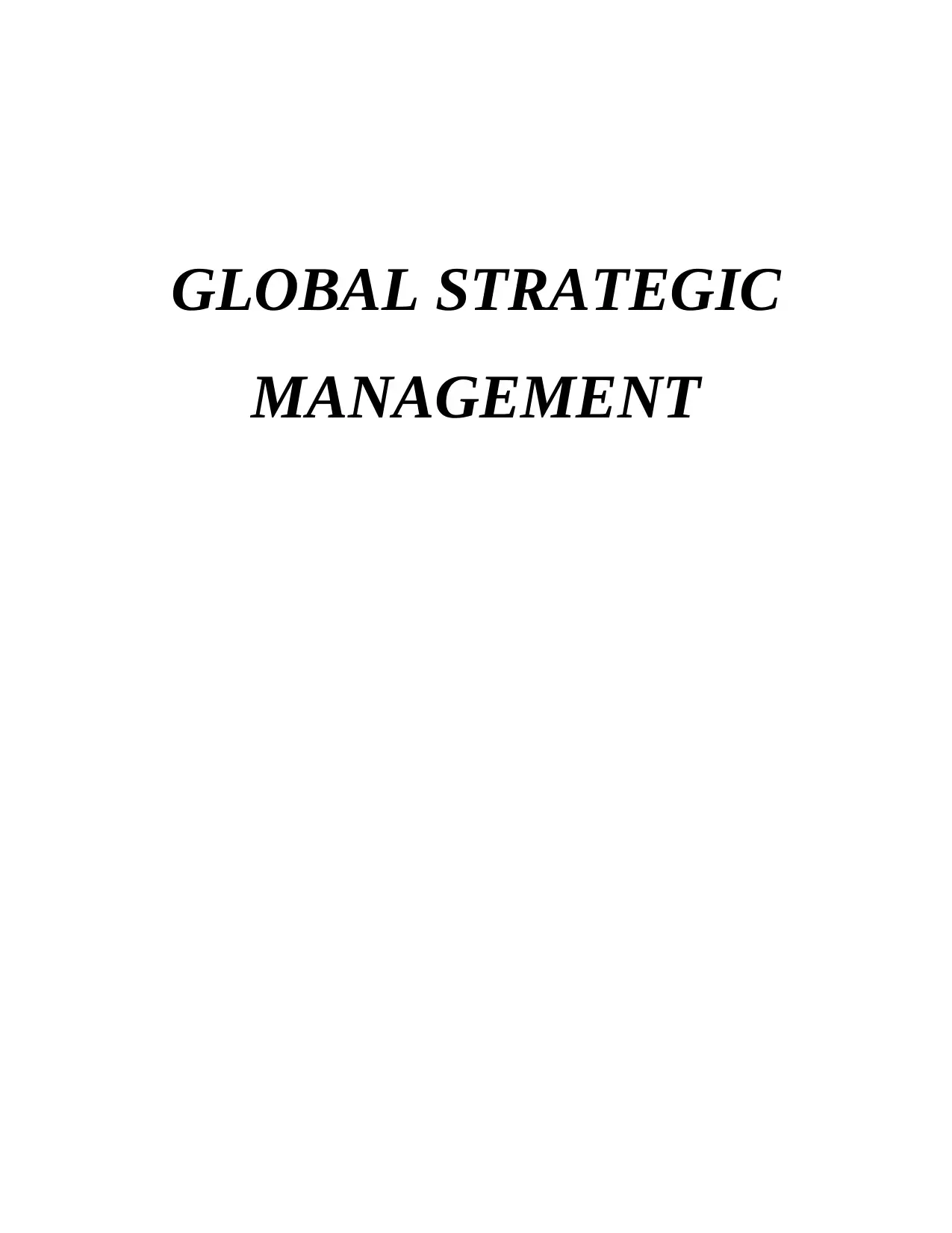
GLOBAL STRATEGIC
MANAGEMENT
MANAGEMENT
Paraphrase This Document
Need a fresh take? Get an instant paraphrase of this document with our AI Paraphraser
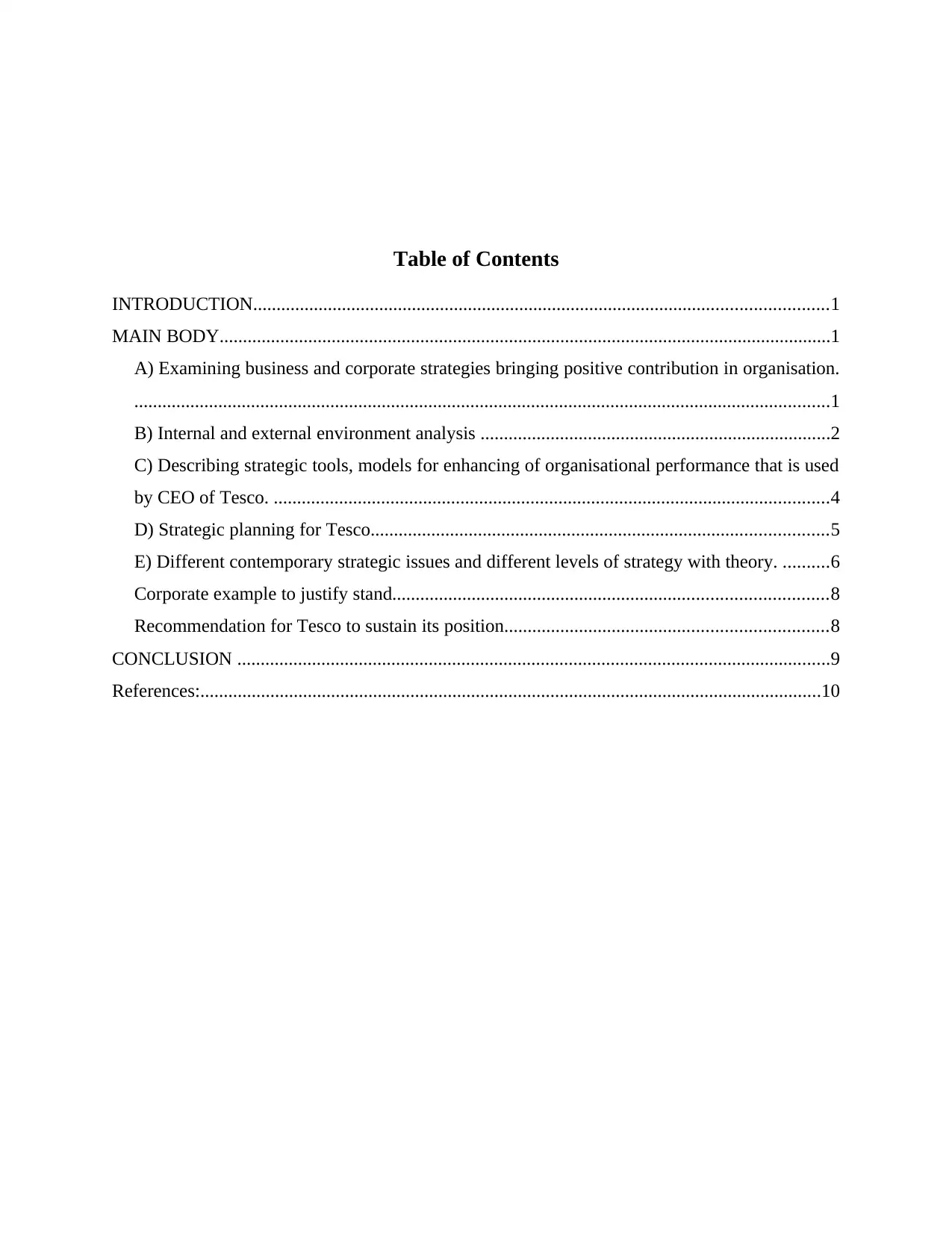
Table of Contents
INTRODUCTION...........................................................................................................................1
MAIN BODY...................................................................................................................................1
A) Examining business and corporate strategies bringing positive contribution in organisation.
.....................................................................................................................................................1
B) Internal and external environment analysis ...........................................................................2
C) Describing strategic tools, models for enhancing of organisational performance that is used
by CEO of Tesco. .......................................................................................................................4
D) Strategic planning for Tesco..................................................................................................5
E) Different contemporary strategic issues and different levels of strategy with theory. ..........6
Corporate example to justify stand.............................................................................................8
Recommendation for Tesco to sustain its position.....................................................................8
CONCLUSION ...............................................................................................................................9
References:.....................................................................................................................................10
INTRODUCTION...........................................................................................................................1
MAIN BODY...................................................................................................................................1
A) Examining business and corporate strategies bringing positive contribution in organisation.
.....................................................................................................................................................1
B) Internal and external environment analysis ...........................................................................2
C) Describing strategic tools, models for enhancing of organisational performance that is used
by CEO of Tesco. .......................................................................................................................4
D) Strategic planning for Tesco..................................................................................................5
E) Different contemporary strategic issues and different levels of strategy with theory. ..........6
Corporate example to justify stand.............................................................................................8
Recommendation for Tesco to sustain its position.....................................................................8
CONCLUSION ...............................................................................................................................9
References:.....................................................................................................................................10
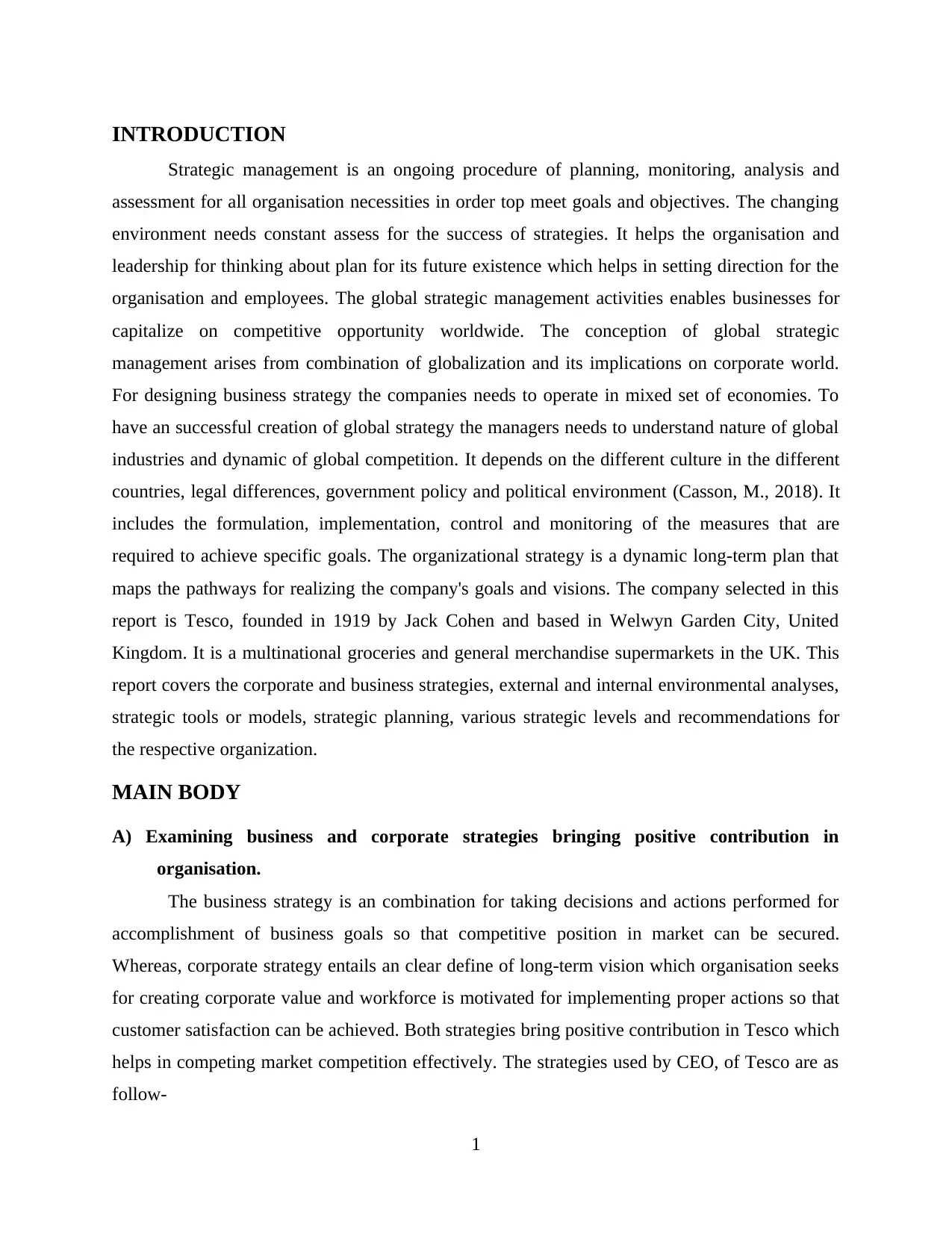
INTRODUCTION
Strategic management is an ongoing procedure of planning, monitoring, analysis and
assessment for all organisation necessities in order top meet goals and objectives. The changing
environment needs constant assess for the success of strategies. It helps the organisation and
leadership for thinking about plan for its future existence which helps in setting direction for the
organisation and employees. The global strategic management activities enables businesses for
capitalize on competitive opportunity worldwide. The conception of global strategic
management arises from combination of globalization and its implications on corporate world.
For designing business strategy the companies needs to operate in mixed set of economies. To
have an successful creation of global strategy the managers needs to understand nature of global
industries and dynamic of global competition. It depends on the different culture in the different
countries, legal differences, government policy and political environment (Casson, M., 2018). It
includes the formulation, implementation, control and monitoring of the measures that are
required to achieve specific goals. The organizational strategy is a dynamic long-term plan that
maps the pathways for realizing the company's goals and visions. The company selected in this
report is Tesco, founded in 1919 by Jack Cohen and based in Welwyn Garden City, United
Kingdom. It is a multinational groceries and general merchandise supermarkets in the UK. This
report covers the corporate and business strategies, external and internal environmental analyses,
strategic tools or models, strategic planning, various strategic levels and recommendations for
the respective organization.
MAIN BODY
A) Examining business and corporate strategies bringing positive contribution in
organisation.
The business strategy is an combination for taking decisions and actions performed for
accomplishment of business goals so that competitive position in market can be secured.
Whereas, corporate strategy entails an clear define of long-term vision which organisation seeks
for creating corporate value and workforce is motivated for implementing proper actions so that
customer satisfaction can be achieved. Both strategies bring positive contribution in Tesco which
helps in competing market competition effectively. The strategies used by CEO, of Tesco are as
follow-
1
Strategic management is an ongoing procedure of planning, monitoring, analysis and
assessment for all organisation necessities in order top meet goals and objectives. The changing
environment needs constant assess for the success of strategies. It helps the organisation and
leadership for thinking about plan for its future existence which helps in setting direction for the
organisation and employees. The global strategic management activities enables businesses for
capitalize on competitive opportunity worldwide. The conception of global strategic
management arises from combination of globalization and its implications on corporate world.
For designing business strategy the companies needs to operate in mixed set of economies. To
have an successful creation of global strategy the managers needs to understand nature of global
industries and dynamic of global competition. It depends on the different culture in the different
countries, legal differences, government policy and political environment (Casson, M., 2018). It
includes the formulation, implementation, control and monitoring of the measures that are
required to achieve specific goals. The organizational strategy is a dynamic long-term plan that
maps the pathways for realizing the company's goals and visions. The company selected in this
report is Tesco, founded in 1919 by Jack Cohen and based in Welwyn Garden City, United
Kingdom. It is a multinational groceries and general merchandise supermarkets in the UK. This
report covers the corporate and business strategies, external and internal environmental analyses,
strategic tools or models, strategic planning, various strategic levels and recommendations for
the respective organization.
MAIN BODY
A) Examining business and corporate strategies bringing positive contribution in
organisation.
The business strategy is an combination for taking decisions and actions performed for
accomplishment of business goals so that competitive position in market can be secured.
Whereas, corporate strategy entails an clear define of long-term vision which organisation seeks
for creating corporate value and workforce is motivated for implementing proper actions so that
customer satisfaction can be achieved. Both strategies bring positive contribution in Tesco which
helps in competing market competition effectively. The strategies used by CEO, of Tesco are as
follow-
1
⊘ This is a preview!⊘
Do you want full access?
Subscribe today to unlock all pages.

Trusted by 1+ million students worldwide
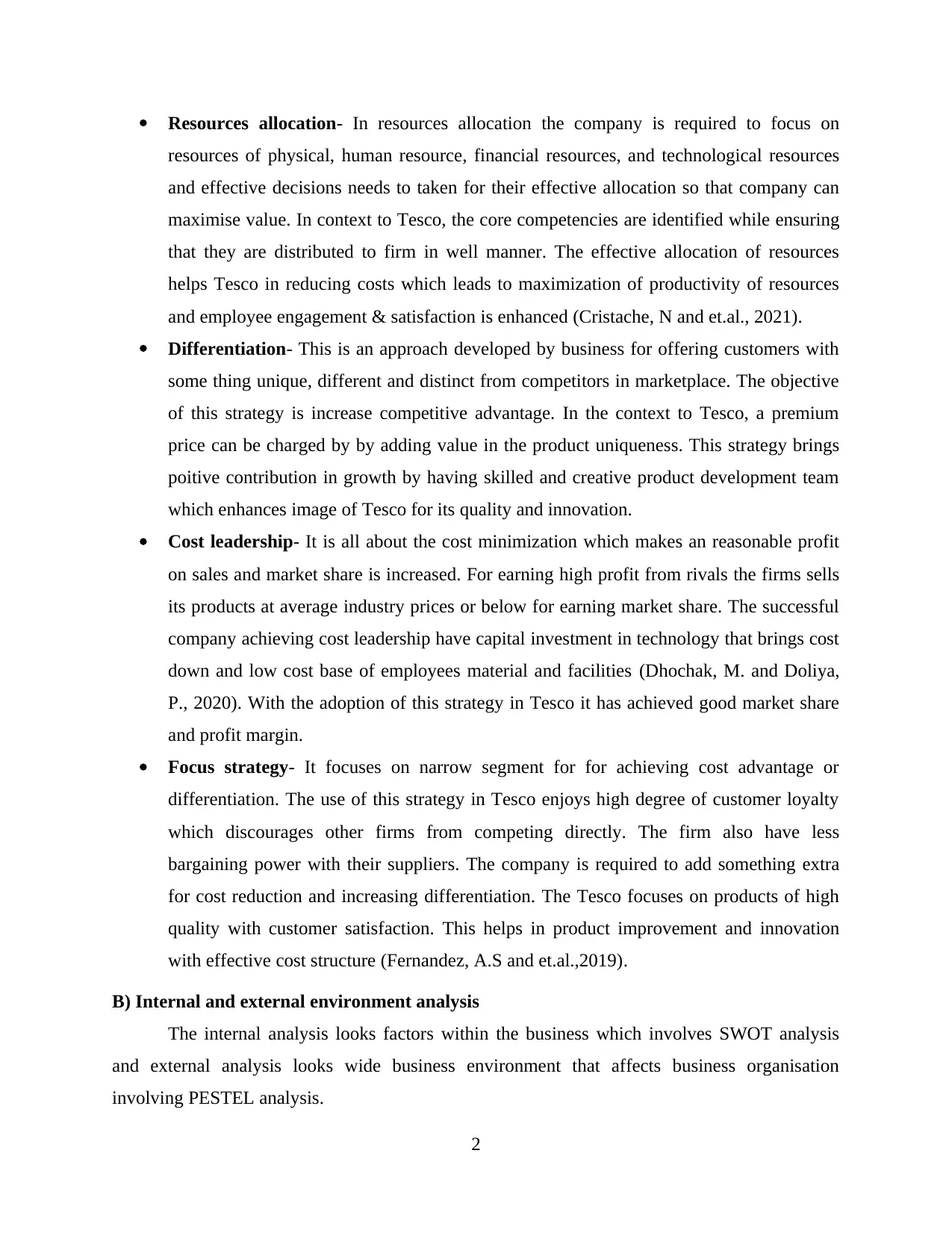
Resources allocation- In resources allocation the company is required to focus on
resources of physical, human resource, financial resources, and technological resources
and effective decisions needs to taken for their effective allocation so that company can
maximise value. In context to Tesco, the core competencies are identified while ensuring
that they are distributed to firm in well manner. The effective allocation of resources
helps Tesco in reducing costs which leads to maximization of productivity of resources
and employee engagement & satisfaction is enhanced (Cristache, N and et.al., 2021).
Differentiation- This is an approach developed by business for offering customers with
some thing unique, different and distinct from competitors in marketplace. The objective
of this strategy is increase competitive advantage. In the context to Tesco, a premium
price can be charged by by adding value in the product uniqueness. This strategy brings
poitive contribution in growth by having skilled and creative product development team
which enhances image of Tesco for its quality and innovation.
Cost leadership- It is all about the cost minimization which makes an reasonable profit
on sales and market share is increased. For earning high profit from rivals the firms sells
its products at average industry prices or below for earning market share. The successful
company achieving cost leadership have capital investment in technology that brings cost
down and low cost base of employees material and facilities (Dhochak, M. and Doliya,
P., 2020). With the adoption of this strategy in Tesco it has achieved good market share
and profit margin.
Focus strategy- It focuses on narrow segment for for achieving cost advantage or
differentiation. The use of this strategy in Tesco enjoys high degree of customer loyalty
which discourages other firms from competing directly. The firm also have less
bargaining power with their suppliers. The company is required to add something extra
for cost reduction and increasing differentiation. The Tesco focuses on products of high
quality with customer satisfaction. This helps in product improvement and innovation
with effective cost structure (Fernandez, A.S and et.al.,2019).
B) Internal and external environment analysis
The internal analysis looks factors within the business which involves SWOT analysis
and external analysis looks wide business environment that affects business organisation
involving PESTEL analysis.
2
resources of physical, human resource, financial resources, and technological resources
and effective decisions needs to taken for their effective allocation so that company can
maximise value. In context to Tesco, the core competencies are identified while ensuring
that they are distributed to firm in well manner. The effective allocation of resources
helps Tesco in reducing costs which leads to maximization of productivity of resources
and employee engagement & satisfaction is enhanced (Cristache, N and et.al., 2021).
Differentiation- This is an approach developed by business for offering customers with
some thing unique, different and distinct from competitors in marketplace. The objective
of this strategy is increase competitive advantage. In the context to Tesco, a premium
price can be charged by by adding value in the product uniqueness. This strategy brings
poitive contribution in growth by having skilled and creative product development team
which enhances image of Tesco for its quality and innovation.
Cost leadership- It is all about the cost minimization which makes an reasonable profit
on sales and market share is increased. For earning high profit from rivals the firms sells
its products at average industry prices or below for earning market share. The successful
company achieving cost leadership have capital investment in technology that brings cost
down and low cost base of employees material and facilities (Dhochak, M. and Doliya,
P., 2020). With the adoption of this strategy in Tesco it has achieved good market share
and profit margin.
Focus strategy- It focuses on narrow segment for for achieving cost advantage or
differentiation. The use of this strategy in Tesco enjoys high degree of customer loyalty
which discourages other firms from competing directly. The firm also have less
bargaining power with their suppliers. The company is required to add something extra
for cost reduction and increasing differentiation. The Tesco focuses on products of high
quality with customer satisfaction. This helps in product improvement and innovation
with effective cost structure (Fernandez, A.S and et.al.,2019).
B) Internal and external environment analysis
The internal analysis looks factors within the business which involves SWOT analysis
and external analysis looks wide business environment that affects business organisation
involving PESTEL analysis.
2
Paraphrase This Document
Need a fresh take? Get an instant paraphrase of this document with our AI Paraphraser
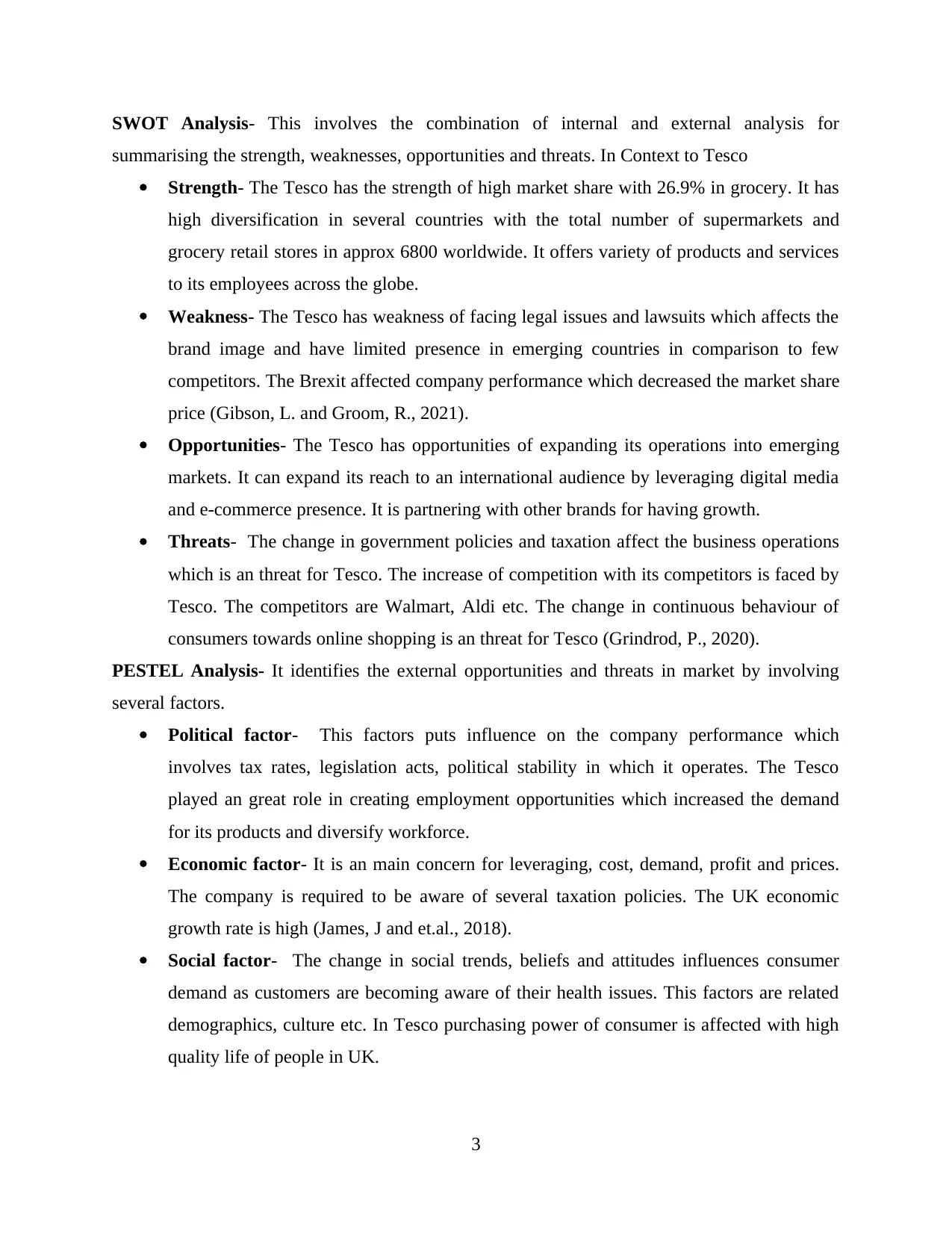
SWOT Analysis- This involves the combination of internal and external analysis for
summarising the strength, weaknesses, opportunities and threats. In Context to Tesco
Strength- The Tesco has the strength of high market share with 26.9% in grocery. It has
high diversification in several countries with the total number of supermarkets and
grocery retail stores in approx 6800 worldwide. It offers variety of products and services
to its employees across the globe.
Weakness- The Tesco has weakness of facing legal issues and lawsuits which affects the
brand image and have limited presence in emerging countries in comparison to few
competitors. The Brexit affected company performance which decreased the market share
price (Gibson, L. and Groom, R., 2021).
Opportunities- The Tesco has opportunities of expanding its operations into emerging
markets. It can expand its reach to an international audience by leveraging digital media
and e-commerce presence. It is partnering with other brands for having growth.
Threats- The change in government policies and taxation affect the business operations
which is an threat for Tesco. The increase of competition with its competitors is faced by
Tesco. The competitors are Walmart, Aldi etc. The change in continuous behaviour of
consumers towards online shopping is an threat for Tesco (Grindrod, P., 2020).
PESTEL Analysis- It identifies the external opportunities and threats in market by involving
several factors.
Political factor- This factors puts influence on the company performance which
involves tax rates, legislation acts, political stability in which it operates. The Tesco
played an great role in creating employment opportunities which increased the demand
for its products and diversify workforce.
Economic factor- It is an main concern for leveraging, cost, demand, profit and prices.
The company is required to be aware of several taxation policies. The UK economic
growth rate is high (James, J and et.al., 2018).
Social factor- The change in social trends, beliefs and attitudes influences consumer
demand as customers are becoming aware of their health issues. This factors are related
demographics, culture etc. In Tesco purchasing power of consumer is affected with high
quality life of people in UK.
3
summarising the strength, weaknesses, opportunities and threats. In Context to Tesco
Strength- The Tesco has the strength of high market share with 26.9% in grocery. It has
high diversification in several countries with the total number of supermarkets and
grocery retail stores in approx 6800 worldwide. It offers variety of products and services
to its employees across the globe.
Weakness- The Tesco has weakness of facing legal issues and lawsuits which affects the
brand image and have limited presence in emerging countries in comparison to few
competitors. The Brexit affected company performance which decreased the market share
price (Gibson, L. and Groom, R., 2021).
Opportunities- The Tesco has opportunities of expanding its operations into emerging
markets. It can expand its reach to an international audience by leveraging digital media
and e-commerce presence. It is partnering with other brands for having growth.
Threats- The change in government policies and taxation affect the business operations
which is an threat for Tesco. The increase of competition with its competitors is faced by
Tesco. The competitors are Walmart, Aldi etc. The change in continuous behaviour of
consumers towards online shopping is an threat for Tesco (Grindrod, P., 2020).
PESTEL Analysis- It identifies the external opportunities and threats in market by involving
several factors.
Political factor- This factors puts influence on the company performance which
involves tax rates, legislation acts, political stability in which it operates. The Tesco
played an great role in creating employment opportunities which increased the demand
for its products and diversify workforce.
Economic factor- It is an main concern for leveraging, cost, demand, profit and prices.
The company is required to be aware of several taxation policies. The UK economic
growth rate is high (James, J and et.al., 2018).
Social factor- The change in social trends, beliefs and attitudes influences consumer
demand as customers are becoming aware of their health issues. This factors are related
demographics, culture etc. In Tesco purchasing power of consumer is affected with high
quality life of people in UK.
3
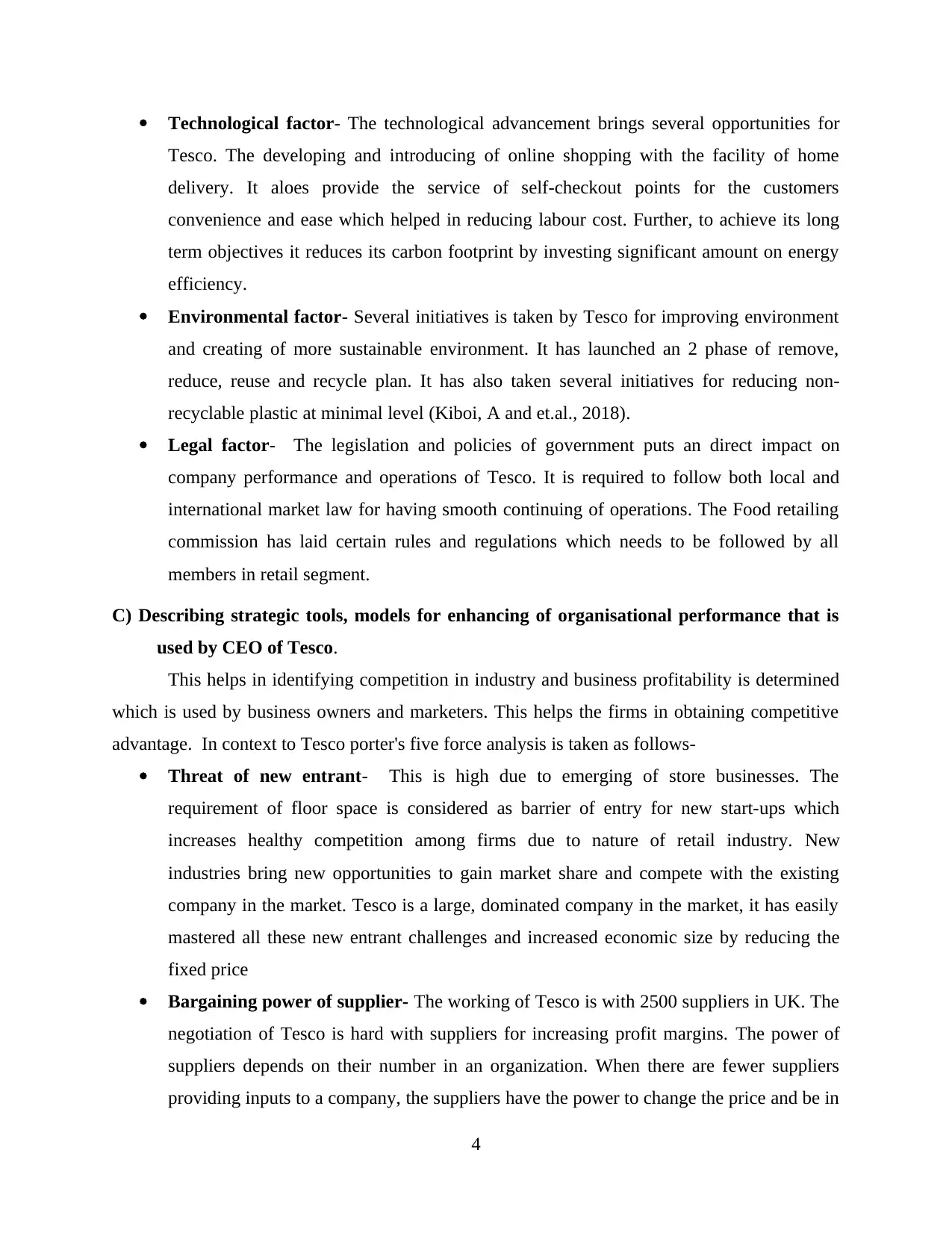
Technological factor- The technological advancement brings several opportunities for
Tesco. The developing and introducing of online shopping with the facility of home
delivery. It aloes provide the service of self-checkout points for the customers
convenience and ease which helped in reducing labour cost. Further, to achieve its long
term objectives it reduces its carbon footprint by investing significant amount on energy
efficiency.
Environmental factor- Several initiatives is taken by Tesco for improving environment
and creating of more sustainable environment. It has launched an 2 phase of remove,
reduce, reuse and recycle plan. It has also taken several initiatives for reducing non-
recyclable plastic at minimal level (Kiboi, A and et.al., 2018).
Legal factor- The legislation and policies of government puts an direct impact on
company performance and operations of Tesco. It is required to follow both local and
international market law for having smooth continuing of operations. The Food retailing
commission has laid certain rules and regulations which needs to be followed by all
members in retail segment.
C) Describing strategic tools, models for enhancing of organisational performance that is
used by CEO of Tesco.
This helps in identifying competition in industry and business profitability is determined
which is used by business owners and marketers. This helps the firms in obtaining competitive
advantage. In context to Tesco porter's five force analysis is taken as follows-
Threat of new entrant- This is high due to emerging of store businesses. The
requirement of floor space is considered as barrier of entry for new start-ups which
increases healthy competition among firms due to nature of retail industry. New
industries bring new opportunities to gain market share and compete with the existing
company in the market. Tesco is a large, dominated company in the market, it has easily
mastered all these new entrant challenges and increased economic size by reducing the
fixed price
Bargaining power of supplier- The working of Tesco is with 2500 suppliers in UK. The
negotiation of Tesco is hard with suppliers for increasing profit margins. The power of
suppliers depends on their number in an organization. When there are fewer suppliers
providing inputs to a company, the suppliers have the power to change the price and be in
4
Tesco. The developing and introducing of online shopping with the facility of home
delivery. It aloes provide the service of self-checkout points for the customers
convenience and ease which helped in reducing labour cost. Further, to achieve its long
term objectives it reduces its carbon footprint by investing significant amount on energy
efficiency.
Environmental factor- Several initiatives is taken by Tesco for improving environment
and creating of more sustainable environment. It has launched an 2 phase of remove,
reduce, reuse and recycle plan. It has also taken several initiatives for reducing non-
recyclable plastic at minimal level (Kiboi, A and et.al., 2018).
Legal factor- The legislation and policies of government puts an direct impact on
company performance and operations of Tesco. It is required to follow both local and
international market law for having smooth continuing of operations. The Food retailing
commission has laid certain rules and regulations which needs to be followed by all
members in retail segment.
C) Describing strategic tools, models for enhancing of organisational performance that is
used by CEO of Tesco.
This helps in identifying competition in industry and business profitability is determined
which is used by business owners and marketers. This helps the firms in obtaining competitive
advantage. In context to Tesco porter's five force analysis is taken as follows-
Threat of new entrant- This is high due to emerging of store businesses. The
requirement of floor space is considered as barrier of entry for new start-ups which
increases healthy competition among firms due to nature of retail industry. New
industries bring new opportunities to gain market share and compete with the existing
company in the market. Tesco is a large, dominated company in the market, it has easily
mastered all these new entrant challenges and increased economic size by reducing the
fixed price
Bargaining power of supplier- The working of Tesco is with 2500 suppliers in UK. The
negotiation of Tesco is hard with suppliers for increasing profit margins. The power of
suppliers depends on their number in an organization. When there are fewer suppliers
providing inputs to a company, the suppliers have the power to change the price and be in
4
⊘ This is a preview!⊘
Do you want full access?
Subscribe today to unlock all pages.

Trusted by 1+ million students worldwide
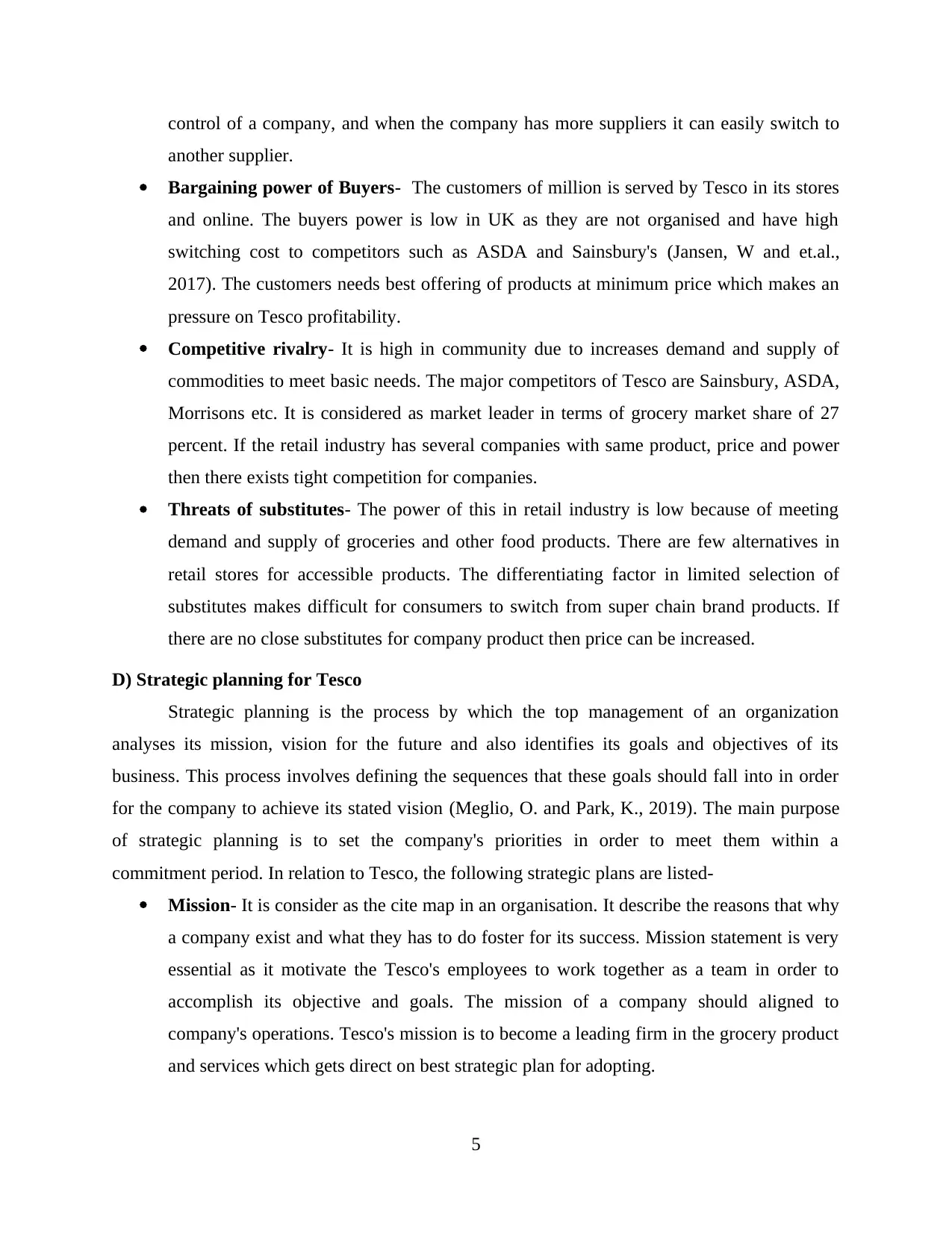
control of a company, and when the company has more suppliers it can easily switch to
another supplier.
Bargaining power of Buyers- The customers of million is served by Tesco in its stores
and online. The buyers power is low in UK as they are not organised and have high
switching cost to competitors such as ASDA and Sainsbury's (Jansen, W and et.al.,
2017). The customers needs best offering of products at minimum price which makes an
pressure on Tesco profitability.
Competitive rivalry- It is high in community due to increases demand and supply of
commodities to meet basic needs. The major competitors of Tesco are Sainsbury, ASDA,
Morrisons etc. It is considered as market leader in terms of grocery market share of 27
percent. If the retail industry has several companies with same product, price and power
then there exists tight competition for companies.
Threats of substitutes- The power of this in retail industry is low because of meeting
demand and supply of groceries and other food products. There are few alternatives in
retail stores for accessible products. The differentiating factor in limited selection of
substitutes makes difficult for consumers to switch from super chain brand products. If
there are no close substitutes for company product then price can be increased.
D) Strategic planning for Tesco
Strategic planning is the process by which the top management of an organization
analyses its mission, vision for the future and also identifies its goals and objectives of its
business. This process involves defining the sequences that these goals should fall into in order
for the company to achieve its stated vision (Meglio, O. and Park, K., 2019). The main purpose
of strategic planning is to set the company's priorities in order to meet them within a
commitment period. In relation to Tesco, the following strategic plans are listed-
Mission- It is consider as the cite map in an organisation. It describe the reasons that why
a company exist and what they has to do foster for its success. Mission statement is very
essential as it motivate the Tesco's employees to work together as a team in order to
accomplish its objective and goals. The mission of a company should aligned to
company's operations. Tesco's mission is to become a leading firm in the grocery product
and services which gets direct on best strategic plan for adopting.
5
another supplier.
Bargaining power of Buyers- The customers of million is served by Tesco in its stores
and online. The buyers power is low in UK as they are not organised and have high
switching cost to competitors such as ASDA and Sainsbury's (Jansen, W and et.al.,
2017). The customers needs best offering of products at minimum price which makes an
pressure on Tesco profitability.
Competitive rivalry- It is high in community due to increases demand and supply of
commodities to meet basic needs. The major competitors of Tesco are Sainsbury, ASDA,
Morrisons etc. It is considered as market leader in terms of grocery market share of 27
percent. If the retail industry has several companies with same product, price and power
then there exists tight competition for companies.
Threats of substitutes- The power of this in retail industry is low because of meeting
demand and supply of groceries and other food products. There are few alternatives in
retail stores for accessible products. The differentiating factor in limited selection of
substitutes makes difficult for consumers to switch from super chain brand products. If
there are no close substitutes for company product then price can be increased.
D) Strategic planning for Tesco
Strategic planning is the process by which the top management of an organization
analyses its mission, vision for the future and also identifies its goals and objectives of its
business. This process involves defining the sequences that these goals should fall into in order
for the company to achieve its stated vision (Meglio, O. and Park, K., 2019). The main purpose
of strategic planning is to set the company's priorities in order to meet them within a
commitment period. In relation to Tesco, the following strategic plans are listed-
Mission- It is consider as the cite map in an organisation. It describe the reasons that why
a company exist and what they has to do foster for its success. Mission statement is very
essential as it motivate the Tesco's employees to work together as a team in order to
accomplish its objective and goals. The mission of a company should aligned to
company's operations. Tesco's mission is to become a leading firm in the grocery product
and services which gets direct on best strategic plan for adopting.
5
Paraphrase This Document
Need a fresh take? Get an instant paraphrase of this document with our AI Paraphraser
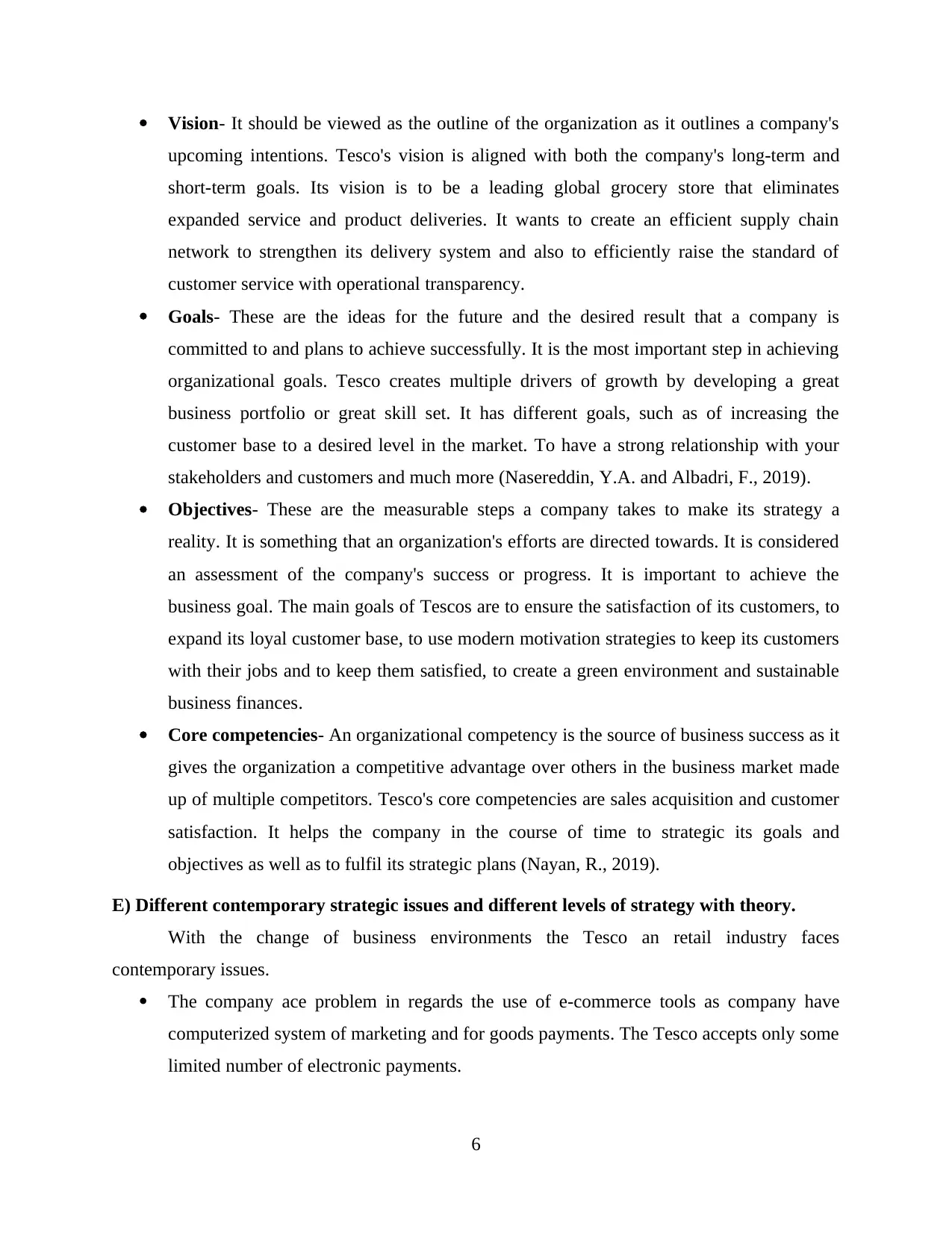
Vision- It should be viewed as the outline of the organization as it outlines a company's
upcoming intentions. Tesco's vision is aligned with both the company's long-term and
short-term goals. Its vision is to be a leading global grocery store that eliminates
expanded service and product deliveries. It wants to create an efficient supply chain
network to strengthen its delivery system and also to efficiently raise the standard of
customer service with operational transparency.
Goals- These are the ideas for the future and the desired result that a company is
committed to and plans to achieve successfully. It is the most important step in achieving
organizational goals. Tesco creates multiple drivers of growth by developing a great
business portfolio or great skill set. It has different goals, such as of increasing the
customer base to a desired level in the market. To have a strong relationship with your
stakeholders and customers and much more (Nasereddin, Y.A. and Albadri, F., 2019).
Objectives- These are the measurable steps a company takes to make its strategy a
reality. It is something that an organization's efforts are directed towards. It is considered
an assessment of the company's success or progress. It is important to achieve the
business goal. The main goals of Tescos are to ensure the satisfaction of its customers, to
expand its loyal customer base, to use modern motivation strategies to keep its customers
with their jobs and to keep them satisfied, to create a green environment and sustainable
business finances.
Core competencies- An organizational competency is the source of business success as it
gives the organization a competitive advantage over others in the business market made
up of multiple competitors. Tesco's core competencies are sales acquisition and customer
satisfaction. It helps the company in the course of time to strategic its goals and
objectives as well as to fulfil its strategic plans (Nayan, R., 2019).
E) Different contemporary strategic issues and different levels of strategy with theory.
With the change of business environments the Tesco an retail industry faces
contemporary issues.
The company ace problem in regards the use of e-commerce tools as company have
computerized system of marketing and for goods payments. The Tesco accepts only some
limited number of electronic payments.
6
upcoming intentions. Tesco's vision is aligned with both the company's long-term and
short-term goals. Its vision is to be a leading global grocery store that eliminates
expanded service and product deliveries. It wants to create an efficient supply chain
network to strengthen its delivery system and also to efficiently raise the standard of
customer service with operational transparency.
Goals- These are the ideas for the future and the desired result that a company is
committed to and plans to achieve successfully. It is the most important step in achieving
organizational goals. Tesco creates multiple drivers of growth by developing a great
business portfolio or great skill set. It has different goals, such as of increasing the
customer base to a desired level in the market. To have a strong relationship with your
stakeholders and customers and much more (Nasereddin, Y.A. and Albadri, F., 2019).
Objectives- These are the measurable steps a company takes to make its strategy a
reality. It is something that an organization's efforts are directed towards. It is considered
an assessment of the company's success or progress. It is important to achieve the
business goal. The main goals of Tescos are to ensure the satisfaction of its customers, to
expand its loyal customer base, to use modern motivation strategies to keep its customers
with their jobs and to keep them satisfied, to create a green environment and sustainable
business finances.
Core competencies- An organizational competency is the source of business success as it
gives the organization a competitive advantage over others in the business market made
up of multiple competitors. Tesco's core competencies are sales acquisition and customer
satisfaction. It helps the company in the course of time to strategic its goals and
objectives as well as to fulfil its strategic plans (Nayan, R., 2019).
E) Different contemporary strategic issues and different levels of strategy with theory.
With the change of business environments the Tesco an retail industry faces
contemporary issues.
The company ace problem in regards the use of e-commerce tools as company have
computerized system of marketing and for goods payments. The Tesco accepts only some
limited number of electronic payments.
6
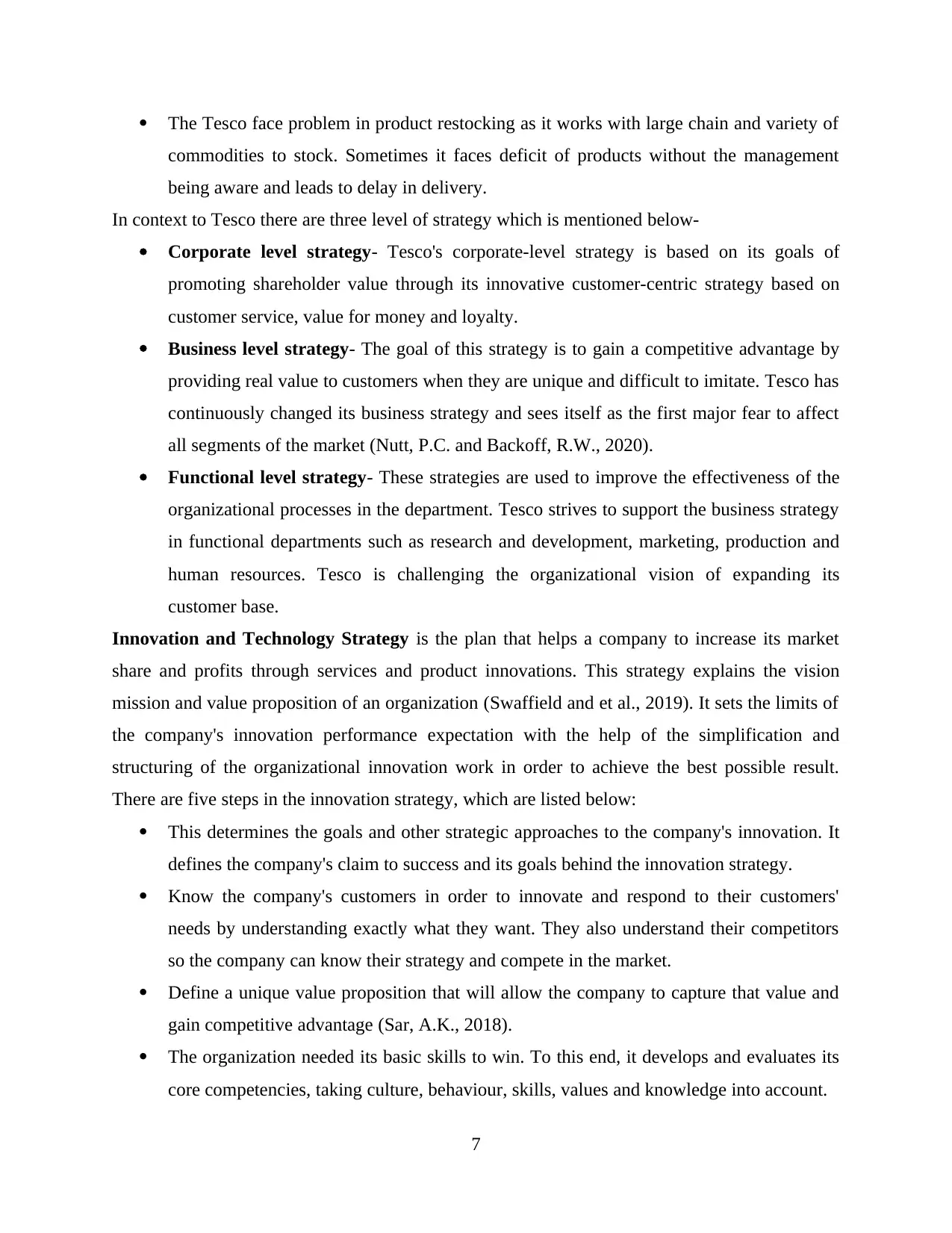
The Tesco face problem in product restocking as it works with large chain and variety of
commodities to stock. Sometimes it faces deficit of products without the management
being aware and leads to delay in delivery.
In context to Tesco there are three level of strategy which is mentioned below-
Corporate level strategy- Tesco's corporate-level strategy is based on its goals of
promoting shareholder value through its innovative customer-centric strategy based on
customer service, value for money and loyalty.
Business level strategy- The goal of this strategy is to gain a competitive advantage by
providing real value to customers when they are unique and difficult to imitate. Tesco has
continuously changed its business strategy and sees itself as the first major fear to affect
all segments of the market (Nutt, P.C. and Backoff, R.W., 2020).
Functional level strategy- These strategies are used to improve the effectiveness of the
organizational processes in the department. Tesco strives to support the business strategy
in functional departments such as research and development, marketing, production and
human resources. Tesco is challenging the organizational vision of expanding its
customer base.
Innovation and Technology Strategy is the plan that helps a company to increase its market
share and profits through services and product innovations. This strategy explains the vision
mission and value proposition of an organization (Swaffield and et al., 2019). It sets the limits of
the company's innovation performance expectation with the help of the simplification and
structuring of the organizational innovation work in order to achieve the best possible result.
There are five steps in the innovation strategy, which are listed below:
This determines the goals and other strategic approaches to the company's innovation. It
defines the company's claim to success and its goals behind the innovation strategy.
Know the company's customers in order to innovate and respond to their customers'
needs by understanding exactly what they want. They also understand their competitors
so the company can know their strategy and compete in the market.
Define a unique value proposition that will allow the company to capture that value and
gain competitive advantage (Sar, A.K., 2018).
The organization needed its basic skills to win. To this end, it develops and evaluates its
core competencies, taking culture, behaviour, skills, values and knowledge into account.
7
commodities to stock. Sometimes it faces deficit of products without the management
being aware and leads to delay in delivery.
In context to Tesco there are three level of strategy which is mentioned below-
Corporate level strategy- Tesco's corporate-level strategy is based on its goals of
promoting shareholder value through its innovative customer-centric strategy based on
customer service, value for money and loyalty.
Business level strategy- The goal of this strategy is to gain a competitive advantage by
providing real value to customers when they are unique and difficult to imitate. Tesco has
continuously changed its business strategy and sees itself as the first major fear to affect
all segments of the market (Nutt, P.C. and Backoff, R.W., 2020).
Functional level strategy- These strategies are used to improve the effectiveness of the
organizational processes in the department. Tesco strives to support the business strategy
in functional departments such as research and development, marketing, production and
human resources. Tesco is challenging the organizational vision of expanding its
customer base.
Innovation and Technology Strategy is the plan that helps a company to increase its market
share and profits through services and product innovations. This strategy explains the vision
mission and value proposition of an organization (Swaffield and et al., 2019). It sets the limits of
the company's innovation performance expectation with the help of the simplification and
structuring of the organizational innovation work in order to achieve the best possible result.
There are five steps in the innovation strategy, which are listed below:
This determines the goals and other strategic approaches to the company's innovation. It
defines the company's claim to success and its goals behind the innovation strategy.
Know the company's customers in order to innovate and respond to their customers'
needs by understanding exactly what they want. They also understand their competitors
so the company can know their strategy and compete in the market.
Define a unique value proposition that will allow the company to capture that value and
gain competitive advantage (Sar, A.K., 2018).
The organization needed its basic skills to win. To this end, it develops and evaluates its
core competencies, taking culture, behaviour, skills, values and knowledge into account.
7
⊘ This is a preview!⊘
Do you want full access?
Subscribe today to unlock all pages.

Trusted by 1+ million students worldwide
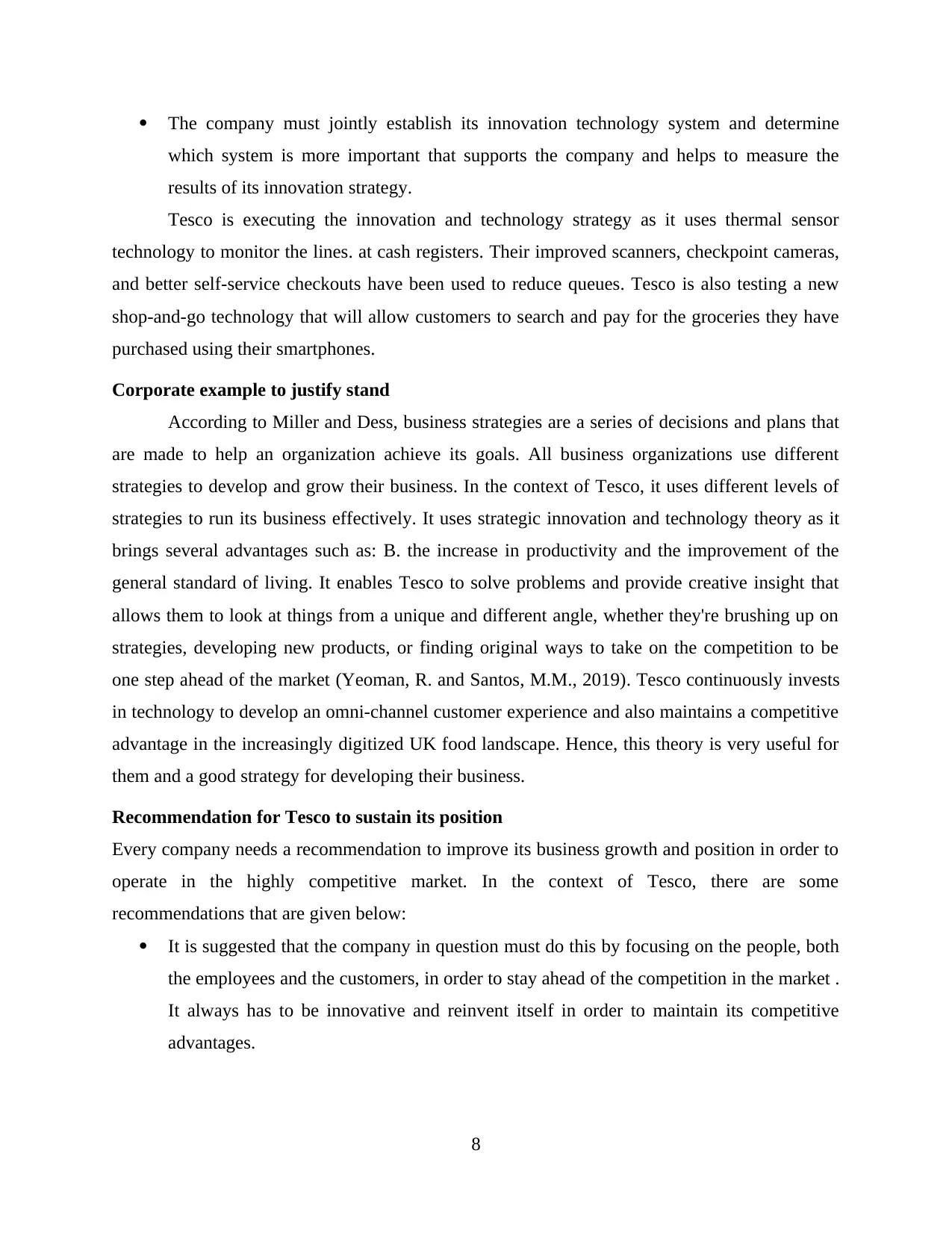
The company must jointly establish its innovation technology system and determine
which system is more important that supports the company and helps to measure the
results of its innovation strategy.
Tesco is executing the innovation and technology strategy as it uses thermal sensor
technology to monitor the lines. at cash registers. Their improved scanners, checkpoint cameras,
and better self-service checkouts have been used to reduce queues. Tesco is also testing a new
shop-and-go technology that will allow customers to search and pay for the groceries they have
purchased using their smartphones.
Corporate example to justify stand
According to Miller and Dess, business strategies are a series of decisions and plans that
are made to help an organization achieve its goals. All business organizations use different
strategies to develop and grow their business. In the context of Tesco, it uses different levels of
strategies to run its business effectively. It uses strategic innovation and technology theory as it
brings several advantages such as: B. the increase in productivity and the improvement of the
general standard of living. It enables Tesco to solve problems and provide creative insight that
allows them to look at things from a unique and different angle, whether they're brushing up on
strategies, developing new products, or finding original ways to take on the competition to be
one step ahead of the market (Yeoman, R. and Santos, M.M., 2019). Tesco continuously invests
in technology to develop an omni-channel customer experience and also maintains a competitive
advantage in the increasingly digitized UK food landscape. Hence, this theory is very useful for
them and a good strategy for developing their business.
Recommendation for Tesco to sustain its position
Every company needs a recommendation to improve its business growth and position in order to
operate in the highly competitive market. In the context of Tesco, there are some
recommendations that are given below:
It is suggested that the company in question must do this by focusing on the people, both
the employees and the customers, in order to stay ahead of the competition in the market .
It always has to be innovative and reinvent itself in order to maintain its competitive
advantages.
8
which system is more important that supports the company and helps to measure the
results of its innovation strategy.
Tesco is executing the innovation and technology strategy as it uses thermal sensor
technology to monitor the lines. at cash registers. Their improved scanners, checkpoint cameras,
and better self-service checkouts have been used to reduce queues. Tesco is also testing a new
shop-and-go technology that will allow customers to search and pay for the groceries they have
purchased using their smartphones.
Corporate example to justify stand
According to Miller and Dess, business strategies are a series of decisions and plans that
are made to help an organization achieve its goals. All business organizations use different
strategies to develop and grow their business. In the context of Tesco, it uses different levels of
strategies to run its business effectively. It uses strategic innovation and technology theory as it
brings several advantages such as: B. the increase in productivity and the improvement of the
general standard of living. It enables Tesco to solve problems and provide creative insight that
allows them to look at things from a unique and different angle, whether they're brushing up on
strategies, developing new products, or finding original ways to take on the competition to be
one step ahead of the market (Yeoman, R. and Santos, M.M., 2019). Tesco continuously invests
in technology to develop an omni-channel customer experience and also maintains a competitive
advantage in the increasingly digitized UK food landscape. Hence, this theory is very useful for
them and a good strategy for developing their business.
Recommendation for Tesco to sustain its position
Every company needs a recommendation to improve its business growth and position in order to
operate in the highly competitive market. In the context of Tesco, there are some
recommendations that are given below:
It is suggested that the company in question must do this by focusing on the people, both
the employees and the customers, in order to stay ahead of the competition in the market .
It always has to be innovative and reinvent itself in order to maintain its competitive
advantages.
8
Paraphrase This Document
Need a fresh take? Get an instant paraphrase of this document with our AI Paraphraser
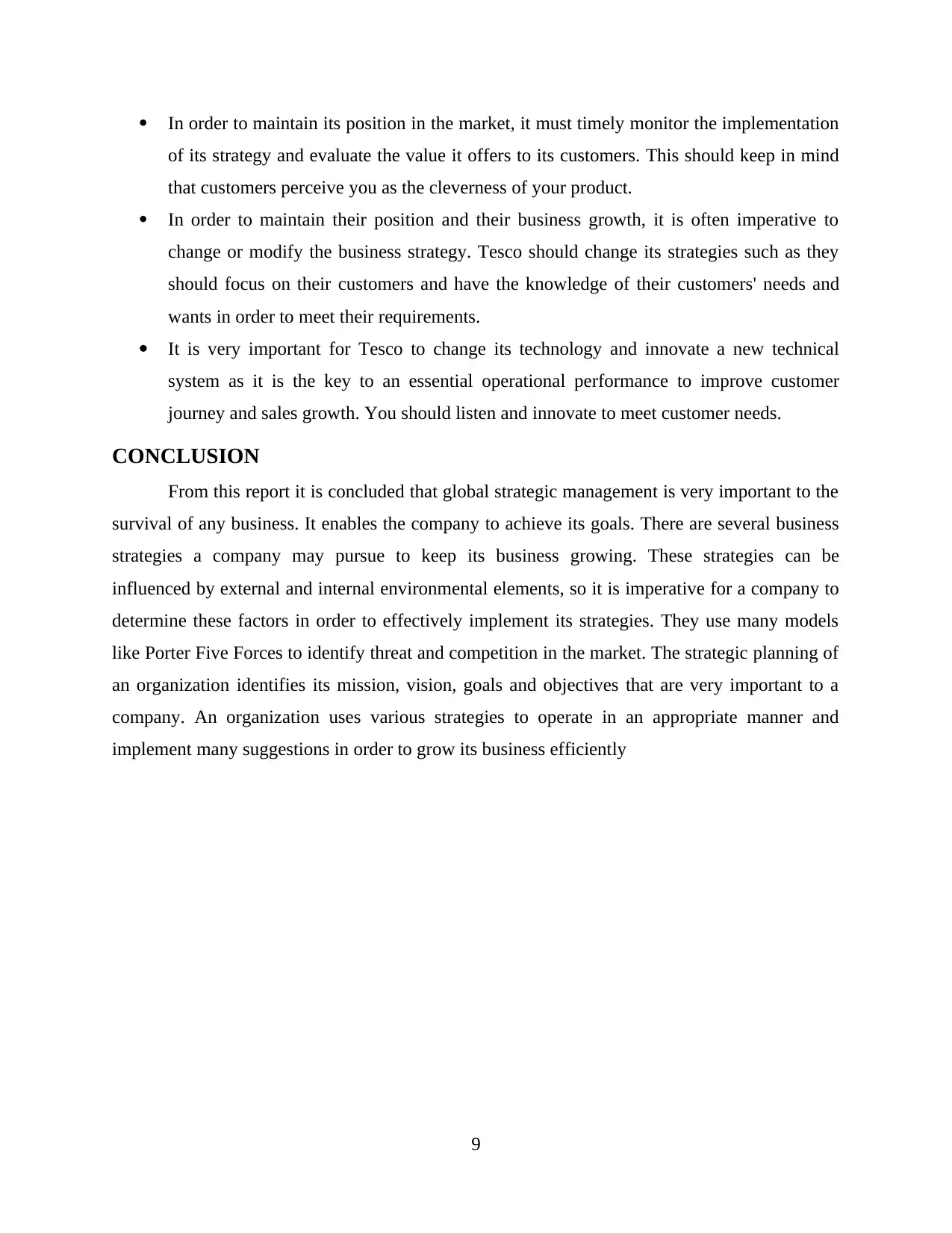
In order to maintain its position in the market, it must timely monitor the implementation
of its strategy and evaluate the value it offers to its customers. This should keep in mind
that customers perceive you as the cleverness of your product.
In order to maintain their position and their business growth, it is often imperative to
change or modify the business strategy. Tesco should change its strategies such as they
should focus on their customers and have the knowledge of their customers' needs and
wants in order to meet their requirements.
It is very important for Tesco to change its technology and innovate a new technical
system as it is the key to an essential operational performance to improve customer
journey and sales growth. You should listen and innovate to meet customer needs.
CONCLUSION
From this report it is concluded that global strategic management is very important to the
survival of any business. It enables the company to achieve its goals. There are several business
strategies a company may pursue to keep its business growing. These strategies can be
influenced by external and internal environmental elements, so it is imperative for a company to
determine these factors in order to effectively implement its strategies. They use many models
like Porter Five Forces to identify threat and competition in the market. The strategic planning of
an organization identifies its mission, vision, goals and objectives that are very important to a
company. An organization uses various strategies to operate in an appropriate manner and
implement many suggestions in order to grow its business efficiently
9
of its strategy and evaluate the value it offers to its customers. This should keep in mind
that customers perceive you as the cleverness of your product.
In order to maintain their position and their business growth, it is often imperative to
change or modify the business strategy. Tesco should change its strategies such as they
should focus on their customers and have the knowledge of their customers' needs and
wants in order to meet their requirements.
It is very important for Tesco to change its technology and innovate a new technical
system as it is the key to an essential operational performance to improve customer
journey and sales growth. You should listen and innovate to meet customer needs.
CONCLUSION
From this report it is concluded that global strategic management is very important to the
survival of any business. It enables the company to achieve its goals. There are several business
strategies a company may pursue to keep its business growing. These strategies can be
influenced by external and internal environmental elements, so it is imperative for a company to
determine these factors in order to effectively implement its strategies. They use many models
like Porter Five Forces to identify threat and competition in the market. The strategic planning of
an organization identifies its mission, vision, goals and objectives that are very important to a
company. An organization uses various strategies to operate in an appropriate manner and
implement many suggestions in order to grow its business efficiently
9
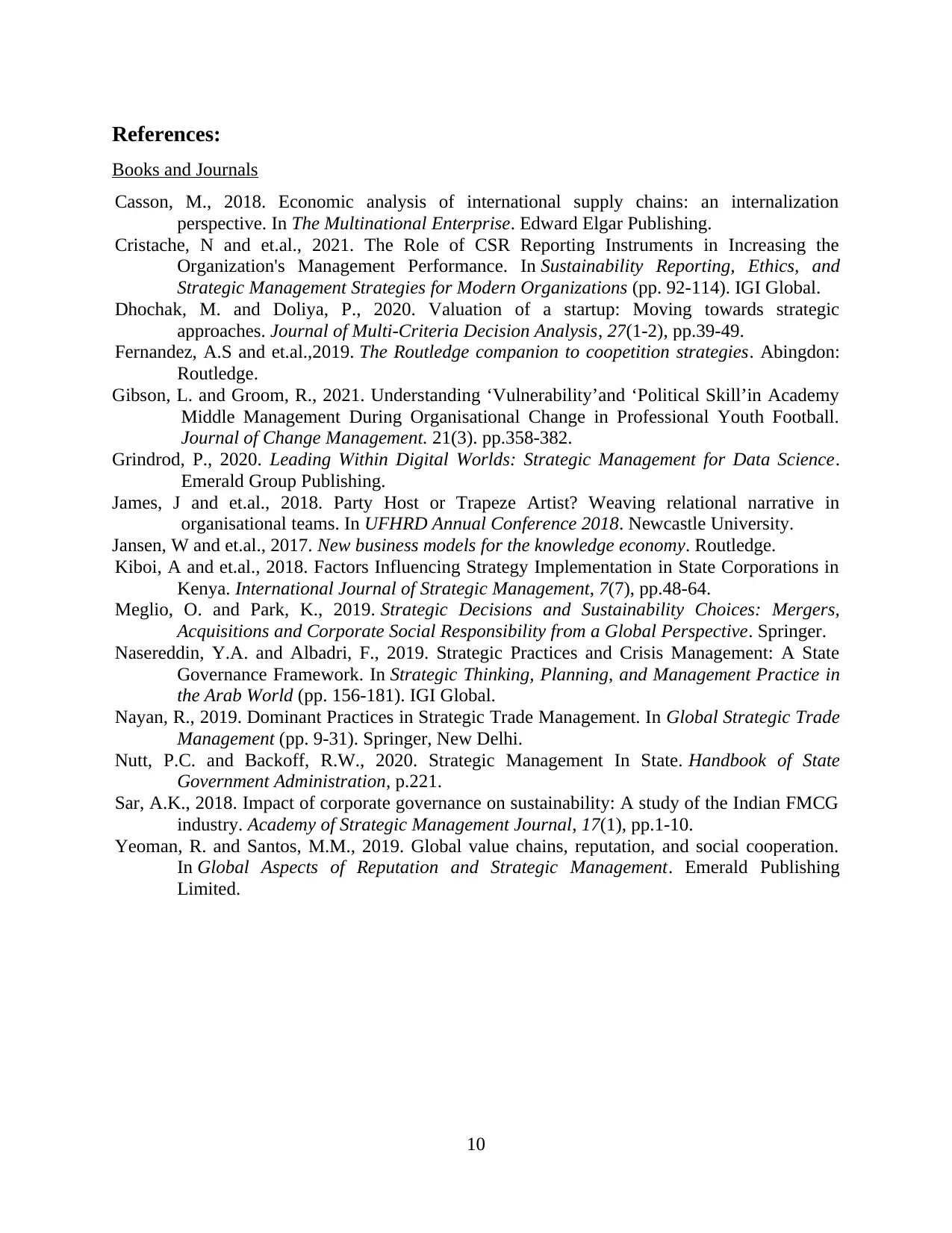
References:
Books and Journals
Casson, M., 2018. Economic analysis of international supply chains: an internalization
perspective. In The Multinational Enterprise. Edward Elgar Publishing.
Cristache, N and et.al., 2021. The Role of CSR Reporting Instruments in Increasing the
Organization's Management Performance. In Sustainability Reporting, Ethics, and
Strategic Management Strategies for Modern Organizations (pp. 92-114). IGI Global.
Dhochak, M. and Doliya, P., 2020. Valuation of a startup: Moving towards strategic
approaches. Journal of Multi‐Criteria Decision Analysis, 27(1-2), pp.39-49.
Fernandez, A.S and et.al.,2019. The Routledge companion to coopetition strategies. Abingdon:
Routledge.
Gibson, L. and Groom, R., 2021. Understanding ‘Vulnerability’and ‘Political Skill’in Academy
Middle Management During Organisational Change in Professional Youth Football.
Journal of Change Management. 21(3). pp.358-382.
Grindrod, P., 2020. Leading Within Digital Worlds: Strategic Management for Data Science.
Emerald Group Publishing.
James, J and et.al., 2018. Party Host or Trapeze Artist? Weaving relational narrative in
organisational teams. In UFHRD Annual Conference 2018. Newcastle University.
Jansen, W and et.al., 2017. New business models for the knowledge economy. Routledge.
Kiboi, A and et.al., 2018. Factors Influencing Strategy Implementation in State Corporations in
Kenya. International Journal of Strategic Management, 7(7), pp.48-64.
Meglio, O. and Park, K., 2019. Strategic Decisions and Sustainability Choices: Mergers,
Acquisitions and Corporate Social Responsibility from a Global Perspective. Springer.
Nasereddin, Y.A. and Albadri, F., 2019. Strategic Practices and Crisis Management: A State
Governance Framework. In Strategic Thinking, Planning, and Management Practice in
the Arab World (pp. 156-181). IGI Global.
Nayan, R., 2019. Dominant Practices in Strategic Trade Management. In Global Strategic Trade
Management (pp. 9-31). Springer, New Delhi.
Nutt, P.C. and Backoff, R.W., 2020. Strategic Management In State. Handbook of State
Government Administration, p.221.
Sar, A.K., 2018. Impact of corporate governance on sustainability: A study of the Indian FMCG
industry. Academy of Strategic Management Journal, 17(1), pp.1-10.
Yeoman, R. and Santos, M.M., 2019. Global value chains, reputation, and social cooperation.
In Global Aspects of Reputation and Strategic Management. Emerald Publishing
Limited.
10
Books and Journals
Casson, M., 2018. Economic analysis of international supply chains: an internalization
perspective. In The Multinational Enterprise. Edward Elgar Publishing.
Cristache, N and et.al., 2021. The Role of CSR Reporting Instruments in Increasing the
Organization's Management Performance. In Sustainability Reporting, Ethics, and
Strategic Management Strategies for Modern Organizations (pp. 92-114). IGI Global.
Dhochak, M. and Doliya, P., 2020. Valuation of a startup: Moving towards strategic
approaches. Journal of Multi‐Criteria Decision Analysis, 27(1-2), pp.39-49.
Fernandez, A.S and et.al.,2019. The Routledge companion to coopetition strategies. Abingdon:
Routledge.
Gibson, L. and Groom, R., 2021. Understanding ‘Vulnerability’and ‘Political Skill’in Academy
Middle Management During Organisational Change in Professional Youth Football.
Journal of Change Management. 21(3). pp.358-382.
Grindrod, P., 2020. Leading Within Digital Worlds: Strategic Management for Data Science.
Emerald Group Publishing.
James, J and et.al., 2018. Party Host or Trapeze Artist? Weaving relational narrative in
organisational teams. In UFHRD Annual Conference 2018. Newcastle University.
Jansen, W and et.al., 2017. New business models for the knowledge economy. Routledge.
Kiboi, A and et.al., 2018. Factors Influencing Strategy Implementation in State Corporations in
Kenya. International Journal of Strategic Management, 7(7), pp.48-64.
Meglio, O. and Park, K., 2019. Strategic Decisions and Sustainability Choices: Mergers,
Acquisitions and Corporate Social Responsibility from a Global Perspective. Springer.
Nasereddin, Y.A. and Albadri, F., 2019. Strategic Practices and Crisis Management: A State
Governance Framework. In Strategic Thinking, Planning, and Management Practice in
the Arab World (pp. 156-181). IGI Global.
Nayan, R., 2019. Dominant Practices in Strategic Trade Management. In Global Strategic Trade
Management (pp. 9-31). Springer, New Delhi.
Nutt, P.C. and Backoff, R.W., 2020. Strategic Management In State. Handbook of State
Government Administration, p.221.
Sar, A.K., 2018. Impact of corporate governance on sustainability: A study of the Indian FMCG
industry. Academy of Strategic Management Journal, 17(1), pp.1-10.
Yeoman, R. and Santos, M.M., 2019. Global value chains, reputation, and social cooperation.
In Global Aspects of Reputation and Strategic Management. Emerald Publishing
Limited.
10
⊘ This is a preview!⊘
Do you want full access?
Subscribe today to unlock all pages.

Trusted by 1+ million students worldwide
1 out of 12
Related Documents
Your All-in-One AI-Powered Toolkit for Academic Success.
+13062052269
info@desklib.com
Available 24*7 on WhatsApp / Email
![[object Object]](/_next/static/media/star-bottom.7253800d.svg)
Unlock your academic potential
Copyright © 2020–2025 A2Z Services. All Rights Reserved. Developed and managed by ZUCOL.




